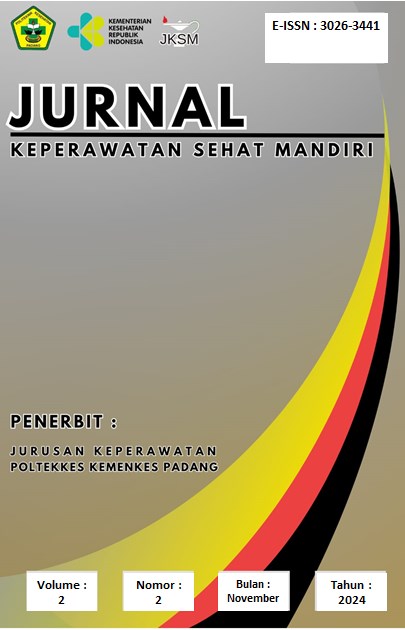Hubungan Stres Dan Indeks Massa Tubuh Dengan Siklus Menstruasi Pada Mahasiswi Jurusan Keperawatan Poltekkes Kemenkes Padang
Abstract
Stress causes irregular menstrual cycle which can cause excessive blood loss, anemia, and even fertility problems. When stressed, an increase in cortisol will inhibits the secretion of gonadotropin-releasing hormone (GnRH), which is influenced by the hormone estrogen. The formation of estrogen by fat tissue is obtained from measurements of body mass index (BMI). So during the proliferation and secretion period, the menstrual cycle will experience shortening or lengthening. This study aims to determine the relationship between stress and body mass index with the menstrual cycle in female students majoring in nursing at the Poltekkes Kemenkes Padang. This research was Analytical Descriptive with a Cross Sectional design. It conducted from December 2022 to July 2023. The population was 349 female students majoring in nursing level 1,2 and 3 with 80 samples. The instruments were the Depression Anxiety Stress Scale (DASS) 42 questionnaire, body weight measurements and the menstrual cycle questionnaire. Data were analyzed using the Chi-Square test. The results showed that there was a relationship between stress (p value = 0.024) and body mass index (p value = 0.045) with the menstrual cycle. Female students are encouraged to adopt a healthy lifestyle, exercise diligently, not stay up late and consult further if there are indications of menstrual cycle disorders. Future researchers can add stress management interventions.
References
Reeder, S.J., Martin, L.L., & Griffin, D.K. (2011). Keperawatan maternitas : Kesehatan wanita, bayi & keluarga edisi 18. Jakarta : EGC.
Barwono. 2012. Ilmu Kebidanan. Jakarta: Yayasan Bina Pustaka.
Kusmiran, E. (2014). Kesehatan Reproduksi Remaja dan Wanita. Jakarta: Salemba Medika.
World Health Organization [WHO]. 201 2. https://www The Prevalence of menstrual cycle disorders. diakses pada tanggal 9 januari 2023
Riskesdas. (2018). Laporan Nasional Riskesdas 2018. Riset Kesehatan Dasar
Ngadiran, C Y., Purnanto, N. T., & others. (2022). The HUBUNGAN STRES DENGAN POLA MENSTRUASI PADA MAHASISWA KEPERAWATAN. Jurnal Bidan Mandira Cendikia, 1(1), 68–72.
Sirait, S. H., Pematangsiantar, P. K., & Medan, P. K. (2019). Hubungan Stress Dan Berat Badan Dengan Siklus Menstruasi Mahasiswi Tingkat I. 4(2), 72–79.
Simbolon, D. E. (2020). Hubungan Tingkat Stres Dengan Siklus Menstruasi Pada Mahasiwa Tingkat Akhir Di Stikes Elisabeth Medan. 90.
Fadillah, R. T., Usman, A. M., & Widowati, R. (2022). Hubungan Tingkat Stres Dengan Siklus Menstruasi Pada Siswi Putri Kelas X Di SMA 12 Kota Depok. MAHESA : Malahayati Health Student Journal, 2(2), 258–269. https://doi.org/10.33024/mahesa.v2i2.5907
Proverawati, Asfuah S. 2009. Buku Ajar Gizi untuk Kebidanan. Yogyakarta: Nuha Medika.
Pretynda, P. R., Nuryanto, I. K., Ayu, P., & Darmayanti, R. (2022). Hubungan Tingkat Stres dengan Siklus Menstruasi pada Remaja Putri dalam Pembelajaran Daring di SMA Negeri 1 Kuta Utara. 7(3), 226–236.
Marlia. Smk, D. I., Utama, W., Tahun, I., Setiawan, D., Kesehatan, J., Vol, M., & Desember, N. (2018). Jurnal kesehatan mahardika. 46–53.
Ruqayah. Kesehatan, J., Pelamonia, D., Kebidanan, A., & Makassar, P. (2020). Hubungan Indeks Massa Tubuh Terhadap Siklus Menstruasi Pada Mahasiswa AKBID Pelamonia Makassar Tahun 2020. 4(1).
Sholichah, N., & Pramiswari, L. I. (2022). Jurnal Komunikasi Kesehatan Vol.XIII No.1 Tahun 2022. 1, 27–33.
Hapsari, S. (2018). Hubungan Indeks Massa Tubuh dengan Siklus Menstruasi pada Siswi Kelas X di SMA Muhamadiyah 7 Yogyakarta. 1–13.
Notoatmodjo, S. (2018). Metodologi Penelitian Kesehatan. Jakarta: Rineka Cipta.
Sabri, H. (2010). Statistik Kasehatan.
Copyright Notice
Pernyataan Hak Cipta dan Lisensi
Dengan mengirimkan manuskrip ke Jurnal Keperawatan Sehat Mandiri, penulis setuju dengan kebijakan ini. Tidak diperlukan persetujuan dokumen khusus.
Hak Cipta :
Lisensi Creative Commons Atribusi-NonKomersial-BerbagiSerupa 4.0 Internasional
Hak cipta atas artikel apa pun di Jurnal Keperawatan Sehat Mandiri dipegang penuh oleh penulisnya di bawah lisensi Creative Commons CC BY-NC-SA 4.0.
- Hak cipta pada setiap artikel adalah milik penulis.
- Penulis mempertahankan semua hak mereka atas karya yang diterbitkan, tak terbatas pada hak-hak yang diatur dalam laman ini.
- Penulis mengakui bahwa Jurnal Keperawatan Sehat Mandiri sebagai yang pertama kali mempublikasikan dengan lisensi Creative Commons Atribusi 4.0 Internasional (CC BY-NC-SA-4.0).
- Penulis dapat memasukan tulisan secara terpisah, mengatur distribusi non-ekskulif dari naskah yang telah terbit di jurnal ini kedalam versi yang lain (misal: dikirim ke respository institusi penulis, publikasi kedalam buku, dll), dengan mengakui bahwa naskah telah terbit pertama kali pada Jurnal Keperawatan Sehat Mandiri
- Penulis menjamin bahwa artikel asli, ditulis oleh penulis yang disebutkan, belum pernah dipublikasikan sebelumnya, tidak mengandung pernyataan yang melanggar hukum, tidak melanggar hak orang lain, tunduk pada hak cipta yang secara eksklusif dipegang oleh penulis.
- Jika artikel dipersiapkan bersama oleh lebih dari satu penulis, setiap penulis yang mengirimkan naskah menjamin bahwa dia telah diberi wewenang oleh semua penulis bersama untuk menyetujui hak cipta dan pemberitahuan lisensi (perjanjian) atas nama mereka, dan setuju untuk memberi tahu rekan penulis persyaratan kebijakan ini. Jurnal Keperawatan Sehat Mandiri tidak akan dimintai pertanggungjawaban atas apa pun yang mungkin timbul karena perselisihan internal penulis.
Lisensi :
Jurnal Keperawatan Sehat Mandiri diterbitkan berdasarkan ketentuan Lisensi Creative Commons Atribusi-NonKomersial-BerbagiSerupa 4.0 Internasional (CC BY-NC-SA 4.0). Lisensi ini mengizinkan setiap orang untuk :
Menyalin dan menyebarluaskan kembali materi ini dalam bentuk atau format apapun serta menggubah, memperbaiki, dan membuat ciptaan turunan, bahkan untuk kepentingan komersial, selama mereka mencantumkan kredit kepada Penulis atas ciptaan asli.

















